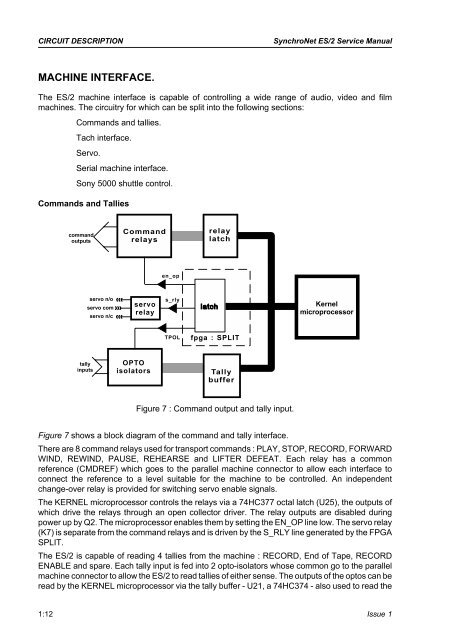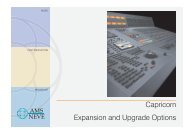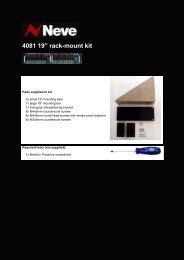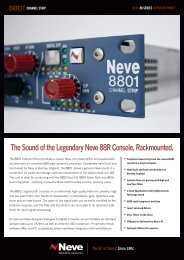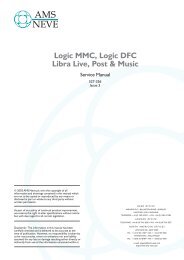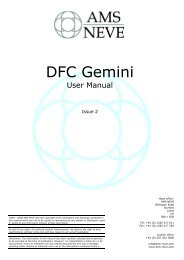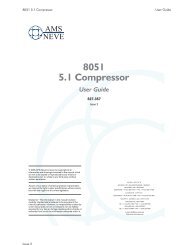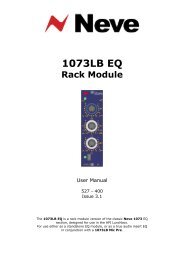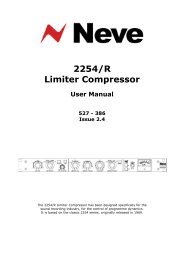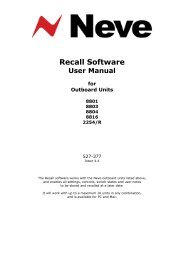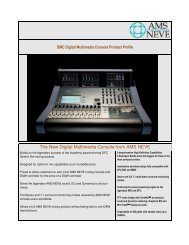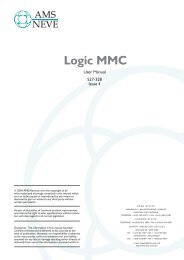Service Manual - AMS Neve
Service Manual - AMS Neve
Service Manual - AMS Neve
Create successful ePaper yourself
Turn your PDF publications into a flip-book with our unique Google optimized e-Paper software.
CIRCUIT DESCRIPTION<br />
SynchroNet ES/2 <strong>Service</strong> <strong>Manual</strong><br />
MACHINE INTERFACE.<br />
The ES/2 machine interface is capable of controlling a wide range of audio, video and film<br />
machines. The circuitry for which can be split into the following sections:<br />
<br />
<br />
<br />
<br />
<br />
Commands and tallies.<br />
Tach interface.<br />
Servo.<br />
Serial machine interface.<br />
Sony 5000 shuttle control.<br />
Commands and Tallies<br />
command<br />
outputs<br />
Command<br />
relays<br />
relay<br />
latch<br />
en_op<br />
servo n/o<br />
servo com<br />
servo n/c<br />
servo<br />
relay<br />
s_rly<br />
Kernel<br />
microprocessor<br />
TPOL<br />
fpga : SPLIT<br />
tally<br />
inputs<br />
OPTO<br />
isolators<br />
Tally<br />
buffer<br />
Figure 7 : Command output and tally input.<br />
Figure 7 shows a block diagram of the command and tally interface.<br />
There are 8 command relays used for transport commands : PLAY, STOP, RECORD, FORWARD<br />
WIND, REWIND, PAUSE, REHEARSE and LIFTER DEFEAT. Each relay has a common<br />
reference (CMDREF) which goes to the parallel machine connector to allow each interface to<br />
connect the reference to a level suitable for the machine to be controlled. An independent<br />
change-over relay is provided for switching servo enable signals.<br />
The KERNEL microprocessor controls the relays via a 74HC377 octal latch (U25), the outputs of<br />
which drive the relays through an open collector driver. The relay outputs are disabled during<br />
power up by Q2. The microprocessor enables them by setting the EN_OP line low. The servo relay<br />
(K7) is separate from the command relays and is driven by the S_RLY line generated by the FPGA<br />
SPLIT.<br />
The ES/2 is capable of reading 4 tallies from the machine : RECORD, End of Tape, RECORD<br />
ENABLE and spare. Each tally input is fed into 2 opto-isolators whose common go to the parallel<br />
machine connector to allow the ES/2 to read tallies of either sense. The outputs of the optos can be<br />
read by the KERNEL microprocessor via the tally buffer - U21, a 74HC374 - also used to read the<br />
1:12 Issue 1


